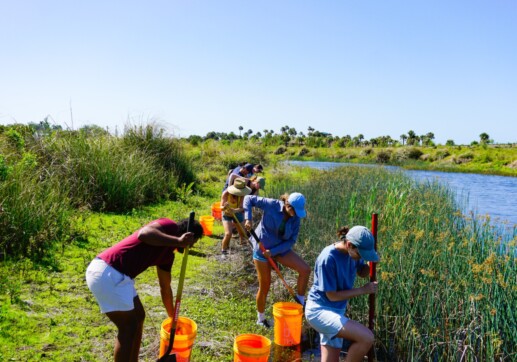The Role of Volunteerism in a DEI Strategy

Going beyond terms to actions
The early morning sun feels warm against your face as you take a sip of your coffee and plead with your body to continue fully waking up. At that moment you feel the soft comfort of your tried-and-true company volunteer t-shirt, filled with nervous excitement and anticipation for the day ahead. It is one of those special days where you are breaking the normal work and home routines and spending the day doing something different. Something that feels truly meaningful, and in service of others.
So many of us can visualize that experience, that moment where we know we are about to spend the day volunteering, team building, and making an impact on people’s lives. In those moments we are often filled with a sense of hope, passion, empathy, and purpose. There are numerous studies showing that we experience many physical and mental health benefits associated with volunteering. This includes stress reduction to reduced levels of depression and anxiety as well as a boost in overall health and satisfaction, including a new perspective on life, and a greater sense of meaning.
Creating Meaningful Experiences
There is no doubt that volunteering is good for us as individuals, important for our local communities, and impactful for our global society. However, what if our volunteering opportunities could go one step further? Volunteer engagements provide a unique opportunity to make progress toward organizational goals around diversity, equity, inclusion, and belonging as well.
As corporate social respponsibility (CSR) professionals, we typically put a lot of intentional thought and time into cultivating impactful and meaningful employee volunteering experiences as well as our broader CSR programs. Frequently looking to strike the balance between larger team building events, deeper level skills-based opportunities, options for individual volunteer activities and a mixture of in-person and virtual engagements to accommodate an increasingly hybrid or remote-first workforce. Yet, what we sometimes overlook is the opportunity to collaborate with our diversity, equity, and inclusion (DEI) colleagues on an integrated strategy and approach.
Connecting with DEI Strategy
To be clear, a larger DEI strategy includes many factors and programs that span across every area of the business. A connection with the CSR strategy and the associated engagement programs is just one element. That said, it can be an extremely powerful element when it is fully coordinated. For example, using a Moments that Matter framework that aligns employee and community activations to key DEI, giving, and service days can be a compelling tool to support a synchronized strategy.
One of the overlooked aspects of volunteering engagements is that they can provide an extraordinary opportunity to achieve goals associated with increasing diversity. For example, volunteering could be used to introduce employees to a set of new experiences and communities, exposing them to diversity of thought, diversity of culture, and diversity of lived experiences. It is often said that growth is only achieved when we are pushed beyond our comfort zone into the learning zone, which can be intimidating at first yet ultimately stretch our existing abilities and lead to the development of new ones.
Separately, volunteering can also be used to provide a more diverse set of employees with the opportunity to lead and cultivate their own critical skill sets. Whether through one-off volunteering events, longer-term skills-based programs, or board service positions, volunteerism can play a key role in helping individual employees grow their leadership skills and hone their own sense of purpose, often leading to higher levels of engagement, retention, and a set of new future leaders for the business.
Finally, volunteering also offers an opportunity for the company to have a broader reach, by working with a greater variety of charities to impact a more diverse set of underrepresented individuals and communities. This thereby provides an opportunity to expand the diversity of impact from the organization’s CSR programs.
Nurturing an Inclusive Corporate Culture
Beyond diversity, volunteerism also offers a chance to build a more inclusive culture and move the needle on larger inclusivity initiatives. First, this starts with the creation of more inclusive volunteering opportunities. As you look to plan out your support for employee volunteering engagements, you can begin by identifying potential barriers. Whether physical, social, or attitudinal, those barriers could be holding employees back from signing up and participating.
Next, you want to make sure that you are creating a portfolio of opportunities that enables a diverse set of employees to engage. One way to do that is by leveraging unique skill sets and recognizing the different specialties and worth of your employee volunteers. This includes making sure that the process for signing up and participating is as frictionless as possible, that communication to employee volunteers is clear and actionable, and most importantly making sure your employees feel appreciated for sharing their time and talents.
Employee resource groups (ERGs) are another way to create a sense of connection between peers and forge clear communication channels about DEI between your employees and your company. Our Roadmap to Investing in DEI through Employee Resource Groups contains strategies for ensuring your ERGs are set up with the right tools and resources that enable them to create a safe space for employees and make meaningful contributions to your company’s CSR efforts.
As you think about building inclusive volunteering events and opportunities, do not forget to make space for post engagement feedback. Gathering honest and transparent feedback from your employee volunteers can help you identify and address areas where you may still need to make adjustments to entice a more diverse set of volunteers and provide a safe and inclusive experience.

